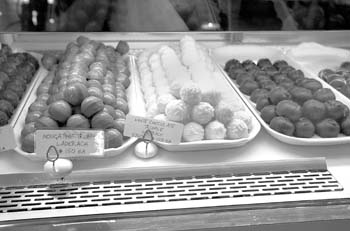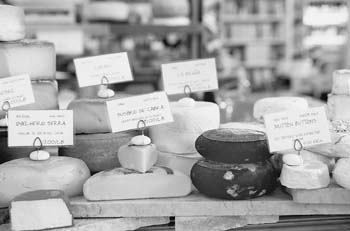![[MetroActive Dining]](/gifs/dining468.gif)
[ Dining Index | Sonoma County | MetroActive Central | Archives ]
Lap of Luxury
Gourmet Groceries--Satisfying Our Urge to Splurge
By Marina Wolf
PEOPLE who hate grocery shopping should live in my head for a week. They'd soon realize that food can be window-shopped as much as cars or jewelry. Even in the most ordinary supermarket, I can find some obscure jar of goods on the top shelf to pick up and examine (the smaller and quirkier the jar, the better). Every few months I visit a local deli to stare through a yellowing fiberglass case at an ancient bottle of balsamic vinegar. On my first trip to New York, I visited the original Dean and DeLuca store in Manhattan--the ultimate upscale market/deli--like a pilgrim to a shrine. My camera lay forgotten against my breathless chest the whole time. My money lasted through six chocolate truffles and a bag of French sea salt, which could have been purchased through the web site or at a Dean and DeLuca store in St. Helena that's about 3,000 miles closer to home. But, no. I wanted to stand physically in the presence of this food, this greatness.
One doesn't analyze a religious experience, not in the heat of it. But as I left the store, I couldn't help noticing the other tourists clutching Dean and DeLuca bags, relics of our devotion. In the days that followed, I wondered about the attraction that drew us through the myriad lures of the Big Apple, to pay $28 for six truffles and the privilege of wandering around this high-priced market for a couple of hours.
What is it, I wondered, that makes expensive food that interesting?
What are we paying for?
Well, status, for starters. Cultural or financial, take your pick. Even this humble writer gets an occasional thrill out of having some little spice or tidbit that my foodie friends haven't heard of. People do this to show off money, too. There are those who simply like to put on a show. One luxury-food writer speaks of caviar thusly: "The most elegant and generous way [emphasis added] to serve caviar is on small, perfectly trimmed pieces of properly toasted bread. The dollop of caviar should never be skimpy."
Don't scrimp, in other words. Load it on.
Such generosity implies that cost is no object--this stuff does, after all, retail for $125 per two-ounce jar. But if you have to show that cost is no object, that reveals that cost is, in fact, the object.
In expensive foods, too, there is usually some suggestion of travel, of exploration of faraway corners of the earth. Once, high-priced luxury foods more accurately reflected the realities of long-distance shipping, whether by train, ship, or camel. With FedEx, the Internet, and phone ordering, distance doesn't cost nearly as much as it used to. But a high price is still a precious reminder of how far this food traveled to land on our plates.
For others, the distance is not as important as the starting point. There is a price for homesickness, and people craving the foods of home are usually willing to pay through the nose. I once paid the equivalent of two weeks' salary for a bag of marshmallows in Russia. I didn't miss them until I saw the package, and then longing overwhelmed all common sense (we made s'mores over the stovetop).
WE PAY, TOO, for a more collective nostalgia, for a taste of making or harvesting or foraging, for a lifestyle that we as a society may have only the faintest, secondhand memory of. Sometimes we have endangered the food supply ourselves, as in the case of lobsters, which once were disdained along the East Coast for being so common. Sometimes the urban, modern way of life is the culprit. We are several generations removed from knowing how to make food items, like bread, jam, or sweet butter, that now command high prices for their creators.
Mushrooms are like this, too.
So many ethnic groups have mushroom-hunting traditions, and finding mushrooms doesn't take any extreme skill, just some guidance and time. But wild mushrooms on the market are some of the most expensive items in the produce section ($35-$50 for fresh porcini). Don't even think of asking the produce person for a sample.
Time, yes, that is also part of the high price of luxury food. Our time is so valuable, but look at what we pay for other people's. We are paying for a taste of their time, because a lot of expensive food has simply been around for a while. A country ham in the Southern United States can hang around in a woodshed for 10 or 11 months (prices run from $50 on up, and you have to pick it up yourself).
The really good English cheddar and Italian Reggiano-Parmigiano cheeses might sit on a shelf for two years or more, and then they sell for at least $25 per pound.
The funny thing about luxury food is that somewhere, most likely at its point of origin, it is really cheap. In the South, that country ham, which has been lauded in gourmet magazines as America's prosciutto, gets fried up for breakfast with red-eye gravy at home.
Saffron retails for $5 to $10 per gram, making it the most expensive food item in the world, ounce for ounce. Where it is grown in Morocco, the locals stuff their teapots with it to flavor their tea.
I try not to think about this truism too much. It only makes me envious of the people who live in caviar country. But that's what luxury food is all about: wanting to be somewhere else, if only to eat.
[ Sonoma County | MetroActive Central | Archives ]
Copyright © Metro Publishing Inc. Maintained by Boulevards New Media.
![]()

Culinary wonderland: A shopper at the Dean and DeLuca store in St. Helena navigates a sea of cheese.

A wealth of tastes: Hand-picked morel mushrooms--$200 a pound.

Sin City: The truffles at the Dean and DeLuca store in St. Helena are affordable and irrestible.

From the May 4-10, 2000 issue of the Sonoma County Independent.